Frequently asked questions about water
Frequently asked questions about natural water
A common cause of red sediment in the water is iron precipitation or natural bacterial activity, in which case the iron bacteria form an orange bacterial mass.
Sometimes seawater can turn red due to the small algae that live there. These types of algae are called the Alexandrium ostenfeldii. Avoid using water and swimming during algal blooming seasons.
Another common reason for water turning a reddish brown in colour is that rock has been drilled nearby and fine rock material has become mixed with the water. The red colour is due to a type of stone called granite, so the water is not harmful. Reddish or cloudy water may come from a tunnel construction site or geothermal well drilling. Construction sites have an obligation to clean the water, but not all of the fine aggregate can be removed.
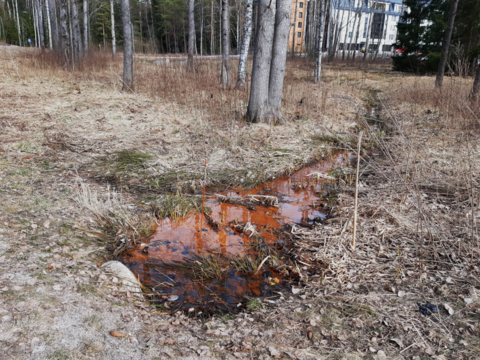
Cloudy grey or pale water in a body of water can be caused by many reasons, and its origin and effects may vary. The turbidity of the water can be a natural phenomenon, such as heavy rains and floods raising sediment and soil to surface water, turning the water cloudy.
However, water can also become cloudy as a result of human activity. For example, in spring, the city washes its streets, during which solid matter can end up in natural waters through a stormwater drain. You can check the location and duration of street washings on the street maintenance level of the City of Espoo’s map service.(external link, opens in a new window)

Solid matter can also end up in a body of water from a construction site if untreated construction site water is discharged into a ditch either directly or through a stormwater drain. If the season does not match in terms of street washing and there is a lot of turbid water spilling into the body of water, it is advisable to contact Environmental Protection.
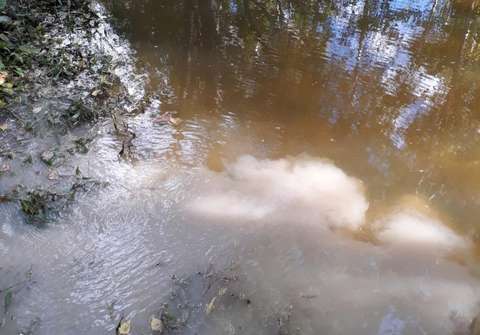
District heating water is coloured green so that possible pipe breaks can be spotted more easily. The district heating water is not toxic. Green water in nature might be a sign of a broken district heating pipe.
Report the sighting to Fortum’s district heating fault reporting hotline at 0800-1-90090, open 24/7. The service is free of charge.
Foam in water usually comes from nature. Natural foam can be white, light or brownish. Foam begins to form when the leaves and twigs that have fallen into lakes and rivers break down. Fatty acids are formed during decomposition, and they are lighter than water and rise to the surface. They lower the surface tension of the water. When the surface tension decreases, air gets mixed into the water. This usually happens in the whirlpools of rapids and streams and the waves of lakes. In autumn and early winter, the foam consists of air bubbles and plant decomposition products mixed with water. In spring, foam is mainly caused by plant inflorescences and pollen that have fallen into the water.
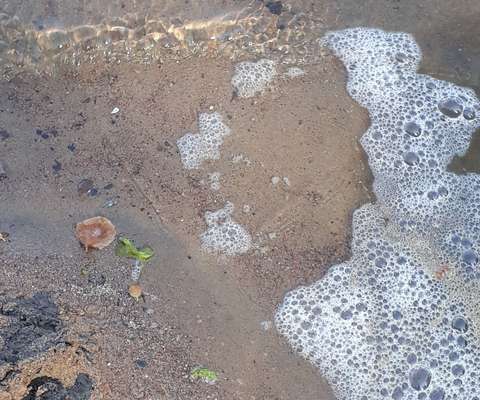
If you see an oily film in rainbow colours, it could be caused by an oil spill or by a naturally occurring metal film that is often found in natural waters. You can determine which one it is by “slicing” the surface with a branch. If there is oil in the water, the “cut” closes immediately to form a mirror-like surface. A metal film, on the other hand, will break into fragments.
Oil spills, big and small, should always be reported by calling the emergency number 112. If you are unsure or there is very little oil-like substance in the water, you can call the Environment Department, Mon–Fri from 10.00 to 15.00, tel. +358 9 81624832 and +358 9 81624842. It is important to notify the authorities immediately.
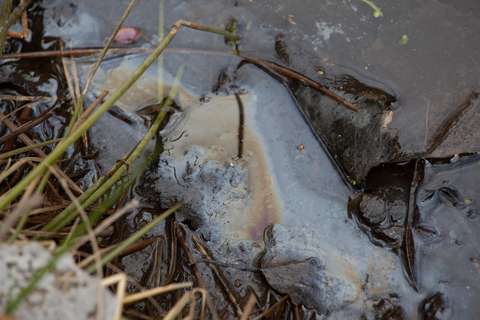
Blue-green algae are actually bacteria also known as cyanobacteria. They are able to photosynthesise with the sun in the same way as algae and plants. Blue-green algae multiply by dividing, which is why their number can increase rapidly in warm and nutrient-rich waters.
Blue-green algae are usually most abundant in mid- and late-summer and usually appear as small greenish nuggets on the surface of the water, and they can accumulate in surface and shallow water and form a thick porridge-like sludge.
The City of Espoo monitors lakes’ temperature and blue-green algae situation. The monitoring results are updated on the webpage for swimming water results website (in Finnish).
Blue-green algae warnings are attached to beaches’ notice boards if the amount of blue-green algae is abundant or very abundant.
There are many species of blue-green algae and some of them can produce various algaecides, such as hepatotoxins and neurotoxins. Toxins can cause a variety of symptoms, such as nausea, fever, red eyes and skin reactions. Species that produce toxins cannot be identified visually from non-toxic species, which is why all blue-green algae must be avoided.
Here is a checklist for the beach:
• Assess the condition of the bathing water before going for a swim.
• Do not swim in water that has blue-green algae.
• Do not allow small children or pets to swim or play in seawater with blue-green algae.
• Do not drink water that has blue-green algae.
• Do not use water that has blue-green algae for washing or in the sauna.
• Instructions for identifying blue-green algae can be found on the website of the National Institute for Health and Welfare.(external link, opens in a new window)
• Information about the algae situation in Finland can be found on the vesi.fi website.(external link, opens in a new window)
• If you suspect that you have symptoms from blue-green algae, contact a doctor.
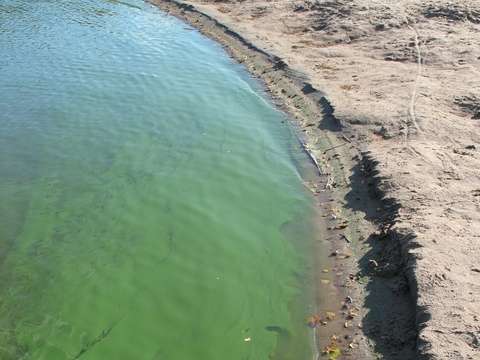
The spherical jelly on the beach is probably a moss animal ( Pectinatella magnifica), an invasive species from North America that is harmless to humans. Moss animals or bryozoa form a spherical uneven clump, ranging from a few centimetres to half a metre in diameter. This clump is a colony inhabited by several thousand bryozoa. Bryozoa reproduce especially in warm and nutrient-rich waters, such as shallow lakes and rivers. Their population can be controlled by removing them from the water and burying them in the ground or composting them. When transferring boats or fishing and crab equipment from one water body to another, careful cleaning and disinfection must always be performed to prevent the spread of invasive species or diseases. Report any observations of bryozoa to the website vieraslaji.fi(external link, opens in a new window) with photographs.
The Finnoo basin is a man-made basin where lightly treated wastewater was discharged in the 1970s. Over time, nutrient-rich wastewater has settled to the bottom of the basin as sludge. From time to time, sludge lumps rise from the bottom of the basin due to water movements and decomposition. A strong smell may occasionally emerge from the basin when the nutrients accumulated at the bottom decompose without oxygen. In summer, when the water warms up, algae may bloom due to the abundance of nutrients.
People monitor their surroundings through their senses. Bacterial activity often causes a bad smell.
A pungent smell similar to the smell of eggs is a sign of hydrogen sulphide, which is caused when bacteria oxidise sulphur in decomposition processes. Finnish lakes are naturally slightly acidic and many water bodies suffer from oxygen deficiency, especially in winter. Eutrophication increases the number of oxygen-consuming organisms and rotting vegetation, thereby increasing the release of sulphur from the sediment. The smell may be an indication that there is no oxygen at the bottom of the body of water.
Iron bacterial activity, on the other hand, produces an earthy odour. This is also a natural process. In addition, cyanobacteria (blue-green algae) also cause an earthy and mouldy odour in the water.
Frequently asked questions about stormwater
The placement of pipes and other structures in an area owned by the city requires a placement permit and, on a case-by-case basis, an excavation permit. Directing water to a city-owned area or an open ditch requires consent in accordance with Section 103g of the Land Use and Building Act. These are applied for electronically through the city’s customer service. If there is a stormwater drain located next to the property, you may need to apply to the Environmental and Building Department for an exemption from the obligation to connect to the stormwater drain.
One official may be working on up to several dozens of permits and stormwater-related cases. The processing time for a single permit or problem situation varies from a few weeks to several months, including all supplements, consultations and statements. Therefore, it is advisable to start the permit process early and to start the process of solving stormwater problems by talking to the concerned parties yourself.
The maintenance of ditches in public park areas is the responsibility of the city. In matters related to maintenance, you can contact the Public Works Department through the feedback service.(external link, opens in a new window)
Installing a pipe for a ditch always requires the neighbour’s consent, in addition to which the pipe must be designed by a suitable expert to prevent any flooding. However, installing pipes for ditches located on a property is not recommended, because they are considerably more difficult to maintain. Any flooding caused by a blocked pipe-covered ditch and any damage caused by it are the responsibility of the property owner(s) responsible for the pipe work.
Leaves and twigs have accumulated in the open ditch between our property and the sidewalk and the ditch is now becoming blocked. Who removes the leaves and twigs?
The maintenance responsibility of the property owner includes the roadside area bordering the plot as well as the ditch located in that area. However, no more than 15 meters from the plot boundary. The removal of debris, leaves and branches is the responsibility of the property owner, but the excavation and deepening of the ditch is the responsibility of the city.
This is a boundary ditch and both properties are responsible for maintaining it.
Rainfall in a natural area and melt water running from that area are not stormwater, they are part of normal surface runoff. There is no obligation to manage them; instead, the responsibility remains with the property. The surrounding area must be taken into account by having, for example, sufficient subsurface drainage or by carrying out any felling in the garden in a way that ensures that the water does not damage the building.
You can wash your car on your own plot as long as you do not use solvents and the washing water does not run into a stormwater drain, open ditch, natural body of water or your neighbour’s plot. In other words, washing is allowed when the water gets absorbed into the ground on site. Washing with a solvent always requires a drain connection fitted with an oil separator.
Frequently asked questions about wastewater
Black wastewater contains toilet water (urine, feces). Grey wastewater is other household wastewater from, for example, the kitchen and washrooms, as well as from cleaning.
If chlorine is added to a swimming pool, tub or jacuzzi, the water to be removed must be directed to a HSY wastewater drain and not to a stormwater drain, nature or your property’s wastewater treatment system. Chlorine does not leave the water, although sales talk says otherwise. Chlorine forms toxic compounds with organic matter.
Frequently asked questions about construction site water
It is always best to try to solve problematic stormwater situations between neighbours. The execution of the construction work, from the start of the work to the final inspection, is supervised by City of Espoo's building control. After the construction work is completed, stormwater and surface water management on the property must comply with the valid building permit.
The quality of the water discharged from the construction site must be monitored at all sites to ensure that the water does not pollute the environment. The person responsible for the water at the construction site must monitor the quality of the water at least through senosory monitoring, for example visually and based on smell.
In addition, it may be necessary to monitor the quality and quantity of the discharged water. If, for example, acid sulphate soil is present in the soil of the construction site, the pH of the discharged water must be monitored through other means in addition to sensory monitoring. More detailed instructions on quality monitoring can be found on HSY’s website in Appendix 1 of the site water guidelines(external link, opens in a new window) (in Finnish).

Construction site water must be properly treated before it is discharged into the stormwater, wastewater or mixed water sewerage drainage system. Discharges of site water into the stormwater, wastewater or mixed sewerage water drainage system must be reported to Helsinki Region Environmental Services HSY. A HSY sewerage permit and a sewerage connection statement are always required to discharge construction site water into a wastewater sewer from the rehabilitation sites of contaminated land or from large excavation site. Read more on the HSY website: Drainage guidelines for construction site water(external link, opens in a new window) (in Finnish)
The construction site water guidelines(external link, opens in a new window) (in Finnish) apply to all construction and renovation sites that generate drainage water. However, if the site is subject to an environmental or water permit or a decision on the remediation of contaminated soil or groundwater, which includes provisions on discharged waters, the provisions of the permit/decision must be complied with in regard to water. There are separate guidelines for the drilling water of geothermal wells.
- Client: Responsible for the realisation of the client’s interests and responsibilities. The client enters into a contract with the contractor and ensures that the project meets the quality requirements.
- Contractor/builder: Responsible for their own activities and work performance, and support the monitoring carried out by the client and the authorities. The contractor ensures that the construction site waters are managed at all stages of the construction contract.
- Regulatory and permit authorities:
- City of Espoo’s building control authorities: Responsible for supervision of construction activities and compliance with legislation.
- Environmental protection authorities of the City of Espoo and the State of Finland: Responsible for the control of harmful effects of construction site waters on the environment.
- Centre for Economic Development, Transport and the Environment (ELY): Responsible for assessing the need for a water permit, sometimes issuing guidelines related to construction site waters.
- Regional State Administrative Agency (AVI): Issues site environmental and water permits.
- Helsinki Region Environmental Services (HSY): Issues permits for the restoration of contaminated soil or large excavation sites and, if necessary, monitors the discharge of water into drains.
In principle, a separate construction site water management plan must be made for all house construction projects. However, the plan is not required when building, for example, a single detached house, semi-detached house or sauna, as these are considered low-impact construction projects.
In infrastructure construction projects, construction site waters and their management are included in construction planning, implementation planning or park planning meetings. If, during the planning process, it is identified that the project generates significant amounts of construction site water, the construction takes place in the area of a sensitive water body or the construction site water may cause harm to the aquatic environment, a preliminary site water management plan is produced as part of the project documents at the end of the planning phase.
In both house construction and infrastructure construction projects, the site water management plan is supplemented and specified in cooperation with the contractor. The developer approves the site water management plan drawn up by the planner and/or contractor, as well as any updates to it. The developer also monitors that the contractor follows the plan. The site water management plan must be presented to the authority upon request.
Description: The nature values and acid sulphate soils of the surrounding area are marked on a map of the construction site. The location of sensitive water bodies has been identified and construction site activities that may affect nature values have been described.
Estimate: The plan estimates where and how much water will be produced on the construction site and where it will be discharged.
Management: A report has been prepared on the selected construction site water management methods and their dimensioning. The locations of the management structures, areas where excavated soil may be dumped, areas where vegetation must be preserved, and routes to be protected against erosion have all been marked on a map.
Monitoring: The plan records how often the functionality of the control methods will be monitored, the necessary maintenance measures and who is responsible for them.
Permits: The possible need for permits, notifications or opinions has been determined.
The construction site water management plan should be displayed in the construction site’s office premises, where it is visible to everyone.